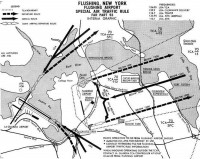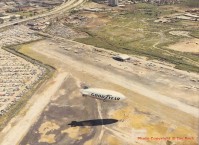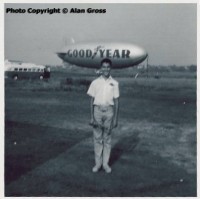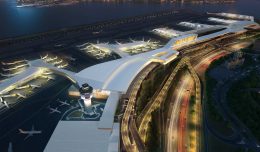Flushing Airport is my Mecca. Currently, the 75-acre property lies dormant with its runways underwater and this former aviation facility’s future remains uncertain. Most of the New York City-owned property is now protected wetlands with about 30 acres of developable land. If I have my way, blimps will once again rise from the property.
The abandoned hangars and office building that have decayed and partially burned down are all that is left of Flushing Airport. I was aware of the airport at a very young age. I would look out my living room window and watch the small planes land and takeoff for hours at a time. In the early 1950’s, my father occasionally drove me over to the airport’s viewing area so I could see the action up close. I actually remember that there were two runways back then. One runway was eventually closed due to safety concerns. I still remember and miss the smell of the airport’s asphalt wafting over my neighborhood.
I must have been around 8 or 9 when Anthony “Speed” Hanzlick asked my father if I would like to go for a ride in his plane. Speed operated the airport and his wife, Mrs. H., worked in the office. My first flight was very exciting and we flew over New York harbor giving me a view of the Statue of Liberty that I would remember to this very day. What a surprise!
Flushing Airport’s history goes back to 1927. It was close to Manhattan and pilots would fly into New York City and land at the College Point property. It was one of the busiest municipal aviation facilities in New York City. It was eventually overshadowed in the mid-30’s by North Beach Airport, which became LaGuardia Airport in 1939. During the 1939-40 World’s Fair at nearby Flushing Meadows, Flushing Airport was the gateway to this magnificent Queens event.
The airport, which had a 3,000-foot north/south runway, also served as a base for the Skytypers and I recall the early morning takeoffs of the World War II planes as they left for their various advertising missions. I looked forward to hearing the engines runup and then roar as the five planes took off one right after the other down the runway. It was like a private airshow!
Initially there were two operators utilizing the airport, Speed’s Flying Service and Edward’s Flying Service. Eventually, Edwards left and created another airfield in Bayport, New York. During World War II, the airport served as a Civil Air Patrol base and patrol units flew missions out of College Point. There was also an aviation school on the property. In the early 1950’s, apartment buildings lined the east end of the airport and began to limit its operations.
I got to know Flushing Airport a lot better in 1964 when two Goodyear blimps moored at the north end and I became a constant visitor to the airport. Speed knew that I had a genuine interest in aviation and introduced my parents and me to the staff of Goodyear’s airship operations. This meeting changed my life and my undying interest in lighter-than-air was born.
The Mayflower and Columbia (the names of the Goodyear blimps) returned to Flushing Airport in 1965. They were the only blimps operating anywhere in the world and they were practically in my back yard! A blimp returned to the airport every year after that through 1976 when Flushing Airport’s future became uncertain and the blimps started to moor at Teterboro Airport in New Jersey.
During the late 1970’s, Speed, Mrs. H., and the airport mechanic Johnny turned over the airport’s operations to Sunrise Aviation and the condition of the airport’s runway started to deteriorate and flood more often. Also, the proximity to an expanding LaGuardia Airport, only a mile or so to the west, sealed the fate of Flushing Airport and it was closed by 1984. However, the Flushing Exclusion, an air corridor overhead that allows small planes, helicopters, and blimps to fly to Manhattan from points north and east, still exists.
The airport had a good run and its presence inspired many north Queens youth to find a career in aviation. I have met pilots, FAA personnel, A&P mechanics and others who started out at Flushing Airport or just watched and were inspired by the planes (such as Cessnas, Aeroncas, Pipers, and Stinsons), helicopters, blimps, and seaplanes takeoff and land throughout the years.
I even recall a special event that was very exciting. The aircraft from the movie “Those Magnificent Men in Their Flying Machines” were brought to the Queens airport and put on display for a few days. To see these old biplanes up close was very exciting and I gained an appreciation for early aviation history.
In the early 1980’s, Dan Aykroyd and Eric Idle came to the airport and shot a comedy sketch for Saturday Night Live using the runway. Around the same time, Marcia Strassman of “Welcome Back, Kotter” fame also shot a scene for the movie “Soup for One.” Celebrities would also appear at the airport during the summer to catch a flight out to the Hamptons on Long Island.
Of course, my passion was for the Goodyear blimps and their presence at Flushing Airport was always thrilling, especially when famous visitors came out to College Point for a ride on one of the magnificent flying behemoths. I recall seeing Mayor Robert Wagner, Arthur Godfrey, Mad magazine creator Bill Gaines, and others take flights on the unique aircraft. A few years ago, a former Goodyear pilot (and my first boss!) told me that the Beatles secretly came out to the airport for a blimp ride.
There were reporters around all the time and the Goodyear blimp pilots were always busy answering the same questions over and over again with courtesy and a friendly smile! I tried to help out the public relations staff by distributing brochures and answering questions outside the office, especially on busy weekends. I worked hard to earn my Goodyear blimp rides. I was proud to be a part of the Goodyear team and was able to also obtain rides for friends and neighbors.
Over the last few years, I was hoping to share the “airship experience” by creating a unique aviation facility on the former Flushing Airport site…a Blimpport! Unfortunately, the real estate market in the College Point Corporate Park has gone wild and New York City officials have disregarded my attempts to submit a Blimpport plan for the property. With airships performing more and more homeland security missions over New York City, having a mooring facility for these flying behemoths at Flushing Airport may not be such a bad idea after all.
In 2004, Mayor Bloomberg and the New York City Economic Development Corporation attempted to sell the property to a group of Korean Wholesalers but the community protested the project, as it would create more traffic problems for an already overburdened infrastructure. The future of Flushing Airport is still up in the air, so to speak. However, I have not given up and if I get my way, lighter-than-air craft will once again return to north Queens.











